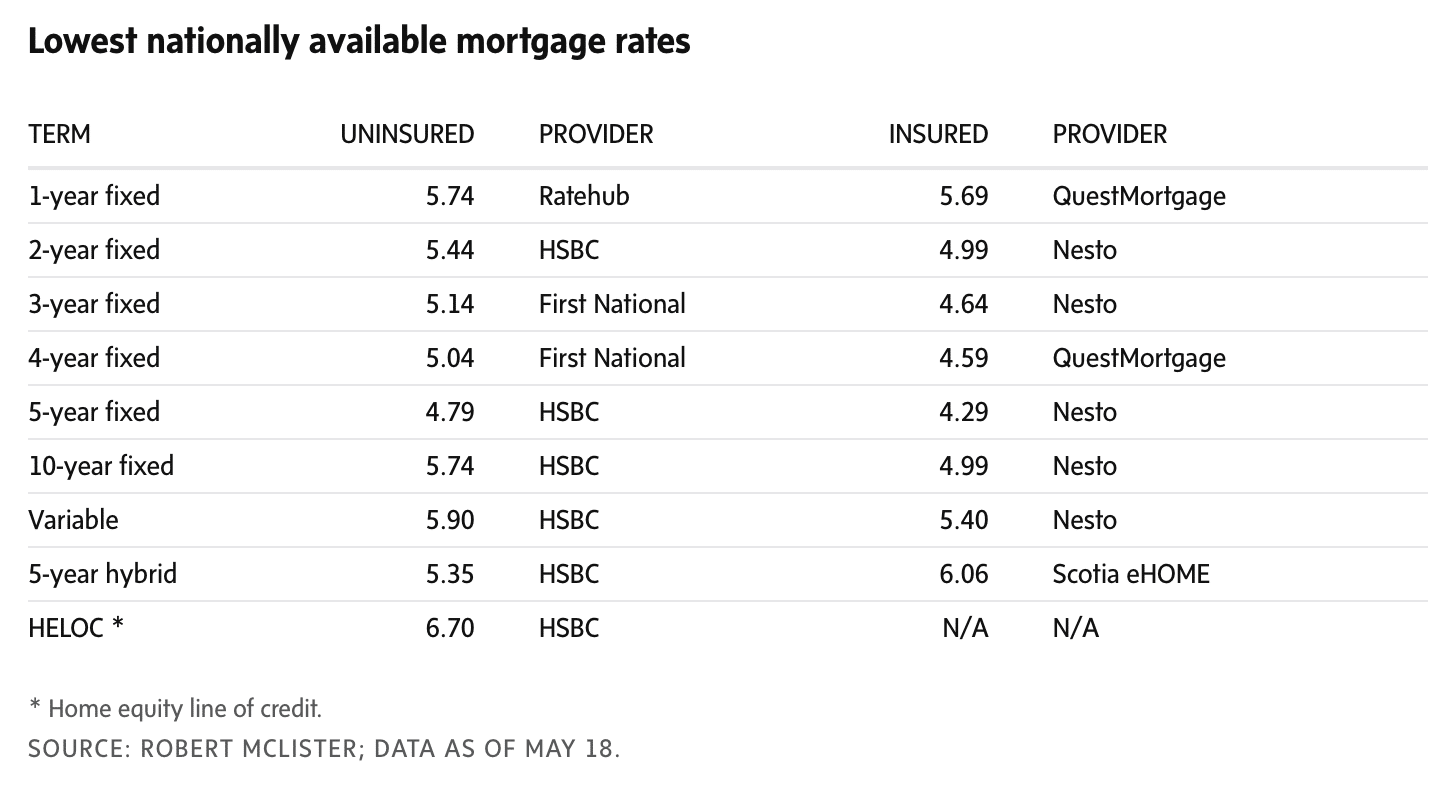Weekend Reading: Best Of Bad Mortgage Options Edition
We’ve finally moved into our new home and received the proceeds from the sale of our previous home. To recap, last year we entered into a purchase agreement to build a new house. We arranged our financing so that we didn’t have to sell the home we were living in to qualify for a new mortgage (avoiding the annoyance of potentially selling too early and having to find short-term accommodations before taking possession of the new house).
To do that, we took out a line of credit on the house we were living in and arranged for a new “draw mortgage” so we could make deposits on the new house as it progressed. The draw mortgage was held at TD in their Flexline product at TD’s prime rate. Needless to say, things got a bit dicey for this personal finance blogger as interest rates soared by 4.25% this past year.
We put our house on the market at the end of January and sold it at the beginning of April for 2.5% below the list price. The buyer’s possession date worked out great – one week after we took possession of our new house.
All-in-all, while the process was stressful given the rapid rise in interest rates, the end result came close to my most optimistic financial outcome (hey, I’m a planner after all).
We put a chunk of the house proceeds down on the Flexline loan and were eager to switch that into a conventional mortgage term. I reached out to friend-of-the-blog and my go-to mortgage expert Rob McLister for some guidance on what to choose in this currently craptacular mortgage environment.
My typical mortgage strategy is to take the best of either a five-year variable rate or a short-term fixed rate. The idea being that variable rate terms tend to perform better than fixed rate terms, but sometimes you can’t get a good discounted variable rate so by going with a 1-or-2-year fixed rate you get a chance to negotiate again sooner than later.
Rob confirmed that strategy was indeed wise and shared the current best available rates:
“Were it me, I definitely would not go past three years and would likely bite the bullet on a 1-year fixed at 5.74% +/-. A lot of banks are quoting 3-year rates at 4.85%. That’s as far out on the curve as any qualified borrower should go. HSBC’s variable at prime minus 0.80% is decent. It has a great no-penalty break policy after 36 months. But based on the market’s implied forward rate outlook (for what that’s worth) a 1-year does a little better on paper, albeit with somewhat more rate risk upfront.”
Rob suggested to stick with a short-term fixed rate and ask TD to beat the best rate I could find elsewhere. That’s exactly what I did when I met with TD last week. Indeed, they matched RateHub’s 1-year fixed rate term at 5.74% (remember, this is an uninsured mortgage as we’ve put down well over 20%).
So we got the best of the bad mortgage options available today. We’ll see how the next 12 months go, and if we do get that elusive recession and/or inflation finally comes back down to target then hopefully we’ll see a drop in mortgage rates next year when we have to renew.
This Week’s Recap:
Last week I shared five investing rules to follow (in good times and bad).
I’m trying to be more active on Instagram and have an Ask Me Anything going on for the next 24 hours in my stories if you want to give me a follow and check that out.
Promo of the Week:
American Express routinely has the most lucrative travel rewards offers on the market and the current promotions for their premium cards are strongly worth considering for travel hackers.
We just booked a premium economy flight to Edinburgh (our favourite city) this summer, as well as business class tickets returning from Amsterdam. All in part to the number of points we earn from American Express cards.
First up, the American Express Aeroplan Reserve Card where you can earn up to 120,000 Aeroplan points (that’s up to $2,400 in value).
Earn 50,000 Aeroplan points after spending $6,000 within the first 3 months. Plus, in the first 6 months, you can also earn 7,500 Aeroplan points for each monthly billing period in which you spend $2,000. That could add up to anther 45,000 Aeroplan points. Finally, you can also earn 25,000 Aeroplan points when you make a purchase between 14 and 17 months of Cardmembership – an incentive to keep the card beyond the one-year mark.
Next we have the American Express Platinum Card, where you can earn up to 90,000 Membership Rewards points when you charge $7,500 in purchases to your Card in the first three months. Membership Rewards can be transferred to Aeroplan on a 1:1 basis, so 90,000 points can be worth up to $1,800 in flight rewards.
For business owners, there isn’t a more lucrative card than the American Express Business Platinum card. It has a high minimum spend requirement – $10,000 in the first three months – but if that’s doable for you then you can earn a cool 100,000 Membership Rewards points.
Finally, while not a new offer, the Amex Cobalt card is the best everyday credit card on the market and my go-to card for spending on food and drinks. Spend $500/month on groceries and you’ll not only max out the 30,000 point welcome bonus but you’ll also earn another 30,000 points from the regular spending. Transfer those 60,000 points to Aeroplan and get up to $1,200 in value from redeeming flight rewards.
Weekend Reading:
After a friendly inflation print for April (coming in higher than expected), borrowers are now concerned about another interest rate hike. Rob McLister explains why that may be disastrous for variable rate mortgage holders.
We often see how Canada Pension Plan is well funded and sustainable for at least the next 75 years. But what about Old Age Security, which is funded by general revenues? Here’s why Canadians can trust that they’ll continue to receive OAS benefits, even with countless economic challenges.
And here’s why you likely won’t get the maximum CPP retirement benefit (subs).
Barry Ritholtz looks at 10 bad takes on this current market.
Anita Bruinsma explains why Canadian investors need exposure to international assets.
Advice-only planner Andrea Thompson looks at a tale of 4 RESPs.
PWL Capital’s Justin Bender offers a helpful comparison between XEQT and VEQT to help you decide between these popular all-equity ETFs:
For business owners – should you pay yourself a salary or dividends (or a mix of both)? This paper looks at the optimal compensation structure for business owners residing in Ontario.
A new paper on finfluencers says investors flock to loudest, least skilled voices on social media. Yikes!
Hey, the 60/40 portfolio is back! (after never going away):
“One outlier year every 4 decades or so makes for a pretty reliable investment strategy. The academic evidence that this sort of investing outperforms all others over a long enough timeline is overwhelming.”
Kyle Prevost at Million Dollar Journey lists eight things you must do to prepare for the death of a spouse.
This is a must read – How retirees can overcome ‘irrational’ saving and enjoy their money:
“The so-called “retirement consumption gap” often stems from an inability to switch off a saving mindset and fears of running out of money, especially as the cost of living rises and people live longer.”
Trying to make up for stock market losses can be costly, impulsive and misguided. Here’s why you keep chasing the wrong stock market.
Finally, a conversation with former Bank of Canada Governor Stephen Poloz on how to adapt to the age of uncertainty. The bottom line: the future is risky, but we’re going to be fine.
Have a great long weekend, everyone!



We require a Wall Street Journal subscription to read “why you keep chasing the wrong stock market”. Is there any chance you can offer a synopsis of the article?
Hello Rob: I currently have had a Cobalt card for 3-yrs and have a pile points. I don’t quite understand your comment about transferring the points to your Aeroplan card. Does this mean you also have a Amex Aeroplane Card. Please explain.
thank you
Gerry
Hi Gerry, no you don’t need an Amex Aeroplan card, you just need to belong to the Aeroplan loyalty program.
When you log-in to your Amex account online you can find an option to transfer points to a bunch of different programs – two popular ones being Aeroplan and Marriott / Bonvoy (hotel rewards).
If you have, say, 100,000 Amex Membership Rewards points you can transfer them to Aeroplan on a 1:1 basis (meaning you’ll have 100,000 Aeroplan miles).
I calculate the value of an Aeroplan mile at 2 cents (the value you get when redeeming for a flight reward). So your 100,000 miles is worth ~$2,000 in flight rewards.
That’s versus keeping the points in Amex Membership Rewards and redeeming the points for a statement credit (100,000 points = $1,000).
Amex also has a travel booking portal but I’m not as familiar with it and couldn’t say what type of value you’d get from redeeming your points that way.
Hi Rob. Would you suggest a couple each getting their own card? Meaning if I got a Reserve card and my wife an Express Platinum card? We spend enough to meet the totals for the reward points on both cards. Or does it make more sense to only get an additional card on the Reserve?
Thanks, Rob
Hi Rob, it makes sense to each get a card. This is called activating Player 2 in the sense that couples who can individually meet minimum spending requirements can earn double the rewards.
My wife and I only have one card that we share with a supplementary card (a long-time Visa for non-Amex everyday spending). Any chance we get we will each get an individual card to max out a bonus.
Hi Rob, We are stressing now as our mortgage is up for renewal. We have an offer in at 5.04 fixed for 5 years but rates might drop in 2024.Today rates went up again! Hubby is thinking variable? I’d rather do fixed. Suggestions?
Hi D.H., I don’t think a five-year variable or a five-year fixed makes sense. If we’re at or near the top of the rate hiking cycle then we can reasonably expect rates to come down in the next 12-24 months.
A short-term fixed (1 or 2 years) might be the sweet spot while we wait for things to unwind.